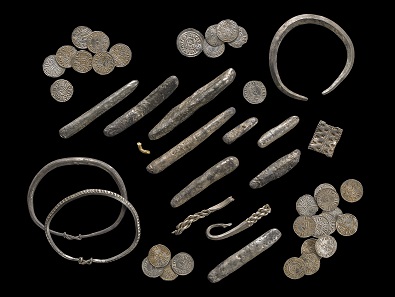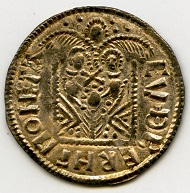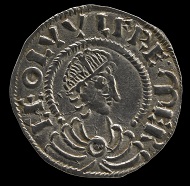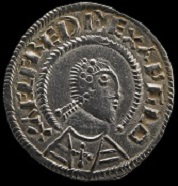February 16, 2017 – The Ashmolean Museum in Oxford delightedly announced that it has raised the £1.35 million required to purchase the hoard of King Alfred the Great discovered in Watlington, Oxfordshire, in 2015. More than 700 members of the public contributed to the appeal. Lead support was provided by the National Lottery through a Heritage Lottery Fund (HLF) grant of £1.05 million to acquire the hoard and fund a range of educational and outreach activities. With a further £150,000 from Art Fund and contributions from private individuals and the Friends and Patrons of the Ashmolean, the Museum reached its fundraising target within days of the deadline.
Watlington Hoard selection. Photo: © Trustees of the British Museum.
Formally acquired, the Museum has launched an HLF funded events and education programme for the hoard. This has begun on 11 February 2017 when the treasures were put on display at the Oxfordshire Museum, Woodstock (until 19 March). In collaboration with Oxfordshire Museums Service, the Ashmolean will stage roadshow events around the county which will include talks, object handling sessions and displays of the objects at locations including Bicester, Faringdon and of course in Watlington. The hoard will also be the focus at the Ashmolean’s annual Festival of Archaeology which takes place every year in July.
Reverse of the ‘Two Emperors’ type coin from the hoard carrying the name of the moneyer, ‘Cuthberht’. © Portable Antiquities Scheme.
The hoard was declared Treasure by the coroner for Oxfordshire in February 2016 and subsequently valued at £1.35 million by the Treasure Valuation Committee. It was discovered on private land near Watlington by metal-detectorist James Mather on 7 October 2015. On the verge of giving up after a frustrating day of finding nothing more than ring-pulls and shotgun cartridges, James chanced upon an object he recognised to be a Viking-age ingot. On finding a further cache of silver pennies close-by he realised he had discovered a hoard.
In the days following, James, the landowner and archaeologist David Williams of the Portable Antiquities Scheme, explored the site and then block-lifted the hoard out of the soil so that it could be taken to the British Museum to be excavated under laboratory conditions. Here it was x-rayed to reveal the contents and the arrangement of the objects within the soil.
James Mather says: ‘This is great news. Finding such an historically significant and valuable hoard is every detectorist’s dream. It just shows how responsible metal detecting, along with supportive landowners and skilled archaeologists, can help secure amazing treasures for the nation’s heritage. I sincerely hope that the Ashmolean will be successful in acquiring this exceptional hoard and look forward to seeing it on display for the inspiration and enjoyment of generations to come.’
Silver pennies of the ‘Two Emperors’ type in the name of Alfred (moneyer Beagstan) and Ceolwulf II (moneyer Hereferth) © Trustees of the British Museum.
Comprising about 200 coins (some of them fragmentary), seven items of jewellery and fifteen ingots (bars of silver), the find is not particularly large, but it is hugely significant because it contains so many coins of Alfred the Great, king of Wessex (r.871–99) and his less well known contemporary, Ceolwulf II of Mercia (r.874–c.879). The vanishingly rare ‘Two Emperors’ penny, of which the hoard contains thirteen examples, shows these two kings seated side-by-side above a winged figure of Victory or an angel. Prior to the discovery of the hoard, only two other examples of the ‘Two Emperors’ were known. The image on the coins suggests an alliance between the kingdoms of Wessex and Mercia. This, remarkably, challenges the accounts found in written sources which dismissed Ceolwulf as a puppet of the Vikings. The coins can therefore offer new insights into this tumultuous period of England’s history and allow us to speculate on Ceolwulf’s disappearance and what role Alfred might have played in his rival’s demise.
‘Two Line’ type penny of Alfred from the hoard; issued by the moneyer ‘Dealing’, probably minted in London. © Portable Antiquities Scheme.
The location and date of the find is also significant. Oxfordshire lay on the border of Mercia and Wessex, and Oxford was one of a number of fortified towns developed under Alfred in part to control the Thames which was used as an important route for Viking ships to strike into the heart of England. Viking forces moved both by water and land, and they likely used the ancient trackway known as Icknield Street which passes through Watlington, close to where the hoard was found. The hoard can be dated by the presence of a single ‘Two-Line’ type penny which was not produced until the late 870s, around the time of the Battle of Edington (May 878) between Alfred’s forces and the Great Heathen Army led by Guthrum. It is possible that the hoard was buried in the wake of this violence or during the ensuing movement of peoples. It is clear that the Watlington Hoard can reveal more about this important moment in the history of England. If acquired by the Museum, it will be studied and published by the Ashmolean’s experts and conservators.
The Alfred Jewel. Gold, enamel and rock crystal, 6.2 x 3.1 x 1.3 cm. Anglo-Saxon, late 9th century. © Ashmolean Museum, University of Oxford.
Dr Xa Sturgis, Director of the Ashmolean, says: „The Watlington Hoard is one of the most exciting and important acquisitions we have ever made, particularly significant because it was found in Oxfordshire. To be able to keep the hoard in the county and put it on display with the Ashmolean’s Anglo-Saxon collections, which include the world-famous Alfred Jewel, was an opportunity we could not miss.“
For more information please visit the Ashmolean Museum website.
To find out more about Alfred and the Anglo-Saxon invasion, watch this BBC documentary.
And to learn more about the regulations on archaeological finds in Britain, please access the website of the Portable Antiquities Scheme.









